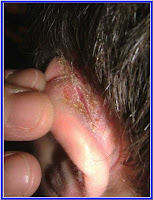History: This healthy 31 yo woman has had an asymptomatic slowly progressive erythematous process on her right arm and shoulder. She is in her second trimester of pregnancy. The reddish areas are slowly getting more pronounced.
O/E: Mat-like telangiectasias on right arm and shoulder: Dermatomal distribution.
Clinical Photo(s):


Lab: N/A
Histopathology: N/A
Diagnosis: Unilateral Nevoid Telangiectasia
Questions:
Reason(s) Presented: For Interest. This is a benign entity, uncommonly encountered, but easy to recognize. The patient appreciates reassurance.
Reference: Unilateral nevoid telangiectasia (UNT) is a cutaneous condition consisting of congenital or acquired patches of superficial telangiectases in a unilateral linear distribution. Described in 1899 by Blaschko, its segmental pattern suggests a mechanism of somatic mosaicism apparent early in life or unmasked in states of relative estrogen excess, such as that in pregnancy or in chronic liver disease. Full Article












